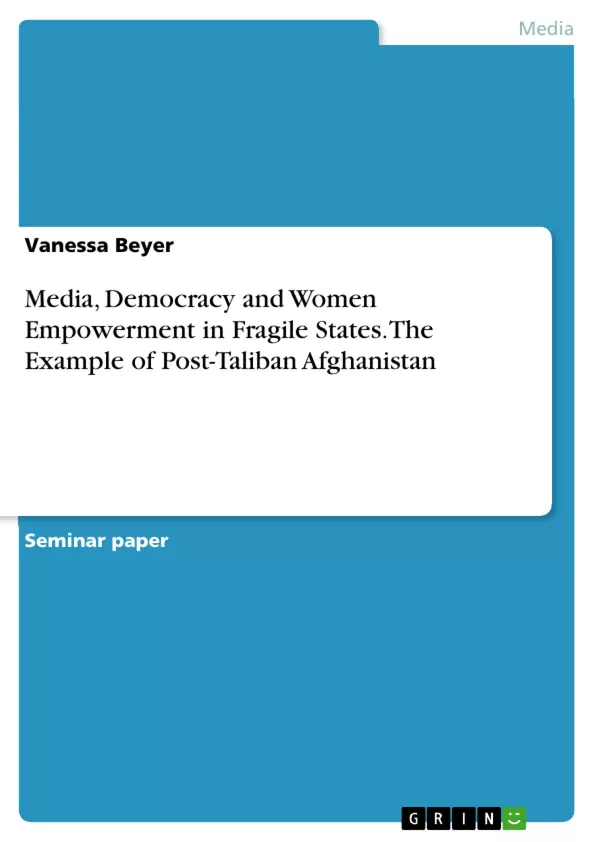This paper aims to identify the role of media in fragile states like Afghanistan in relation to women's opportunities making use of their rights in a self-determined way, and further how media is influencing the social perception on women’s rights regarding different aspects of life. Therefore, this term paper examines how media empowers women in different aspects.
The following questions should thus be addressed: To which extent empowers Afghan media Afghan women and how can the media empower Afghan women further?
In order to understand the specific situation of women in a fragile state like Afghanistan, it is important to define what makes a state fragile and give a short overview on the current status of women’s rights in Afghanistan. In addition to that, the role of women and the importance to involve women in peace-making and -building to establish democratic structures will be outlined. Thereby, the relevance of this work is shown. The research questions posed clearly imply the concept of women empowerment, which is explained in the following section and sets up the categories of analysis for the presented term paper.
In the second part of the paper, the theoretical categories of female empowerment through media are analysed using the example of Afghanistan and further discussing current challenges of female empowerment. The paper concludes with an outlook on further possible steps to be taken by media to promote and enforce women's rights and to overcome gender differences.
Inhaltsverzeichnis (Table of Contents)
- 1. Introduction
- 1.1. Objectives and research questions
- 1.2. Methodology and structure
- 2. Theoretical context
- 2.1. Afghanistan: the fragile situation of a state and women's rights.
- 2.2. Concept of women empowerment and media
- 3. Analytical part: Afghan women empowerment and media
- 3.1. Social empowerment.
- 3.2. Educational empowerment
- 3.3. Economic empowerment
- 3.4. Political empowerment.
- 3.5. New developments: social media as advocacy platform
- 4. Conclusion
Zielsetzung und Themenschwerpunkte (Objectives and Key Themes)
This paper aims to investigate the role of media in empowering women in the context of fragile states, specifically focusing on post-Taliban Afghanistan. It explores the challenges and opportunities for women's empowerment within a fragile state environment, examining the impact of media on social, educational, economic, and political spheres.
- Women's Rights and Empowerment in Fragile States
- The Role of Media in Fostering Social Change and Empowerment
- Challenges and Opportunities for Women's Participation in Afghan Society
- Impact of Media on Women's Empowerment in Afghanistan
- Social Media as a Platform for Advocacy and Women's Voices
Zusammenfassung der Kapitel (Chapter Summaries)
The introduction sets the stage by highlighting the significance of women's empowerment in fragile states, particularly in Afghanistan, where women have faced severe human rights violations. It introduces the research objectives and methodology. Chapter 2 delves into the theoretical context, examining the complex situation of Afghanistan as a fragile state and the concept of women's empowerment, particularly within the media landscape. Chapter 3 presents the analytical part, exploring the impact of media on women's empowerment in Afghanistan across various aspects such as social, educational, economic, and political spheres. It also discusses the emerging role of social media as a platform for advocacy and raising awareness.
Schlüsselwörter (Keywords)
This paper focuses on the themes of women's empowerment, fragile states, media, social change, Afghanistan, gender, political communication, social media, advocacy, and the impact of media on women's participation in social and political life.
- Citar trabajo
- Vanessa Beyer (Autor), 2020, Media, Democracy and Women Empowerment in Fragile States. The Example of Post-Taliban Afghanistan, Múnich, GRIN Verlag, https://www.grin.com/document/1030461



